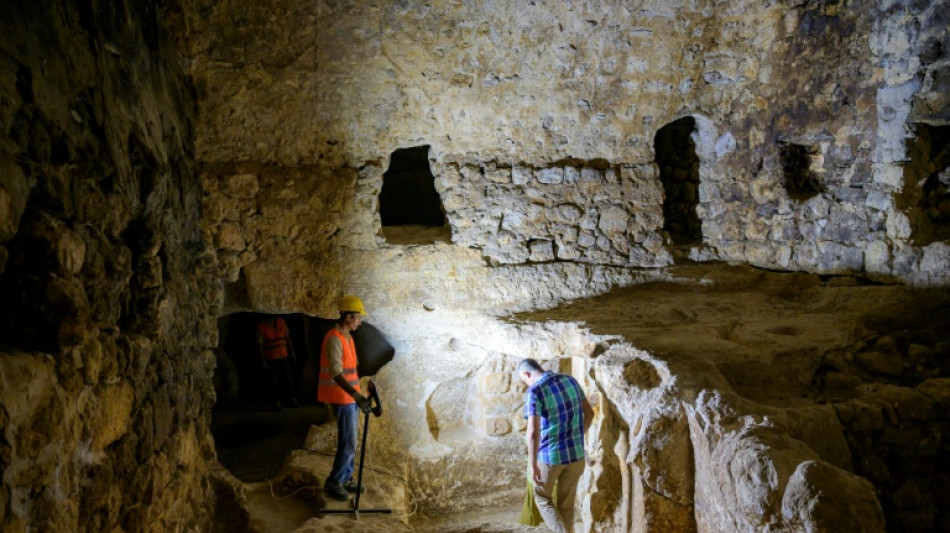
-
 Taylor holds off bloodied Serrano to retain undisputed crown
Taylor holds off bloodied Serrano to retain undisputed crown
-
Japan PM expresses concern to Xi over South China Sea situation

-
 Tens of thousands flee as Super Typhoon Man-yi nears Philippines
Tens of thousands flee as Super Typhoon Man-yi nears Philippines
-
Hoilett gives Canada win in Suriname as Mexico lose to Honduras

-
 Davis, James spark Lakers over Spurs while Cavs stay perfect
Davis, James spark Lakers over Spurs while Cavs stay perfect
-
Mushroom houses for Gaza? Arab designers offer home-grown innovations

-
 Gabon votes on new constitution hailed by junta as 'turning point'
Gabon votes on new constitution hailed by junta as 'turning point'
-
Young Libyans gear up for their first ever election

-
 Vice tightens around remaining civilians in eastern Ukraine
Vice tightens around remaining civilians in eastern Ukraine
-
Dutch coalition survives political turmoil after minister's resignation

-
 Uruguay end winless run with dramatic late win over Colombia
Uruguay end winless run with dramatic late win over Colombia
-
Max potential: 10 years since a teenage Verstappen wowed in Macau

-
 Tens of thousands flee as Typhoon Man-yi nears Philippines
Tens of thousands flee as Typhoon Man-yi nears Philippines
-
Is Argentina's Milei on brink of leaving Paris climate accord?

-
 Big Bang: Trump and Musk could redefine US space strategy
Big Bang: Trump and Musk could redefine US space strategy
-
Revolution over but more protests than ever in Bangladesh

-
 Minister resigns but Dutch coalition remains in place
Minister resigns but Dutch coalition remains in place
-
Ireland won 'ugly', says relieved Farrell

-
 Stirring 'haka' dance disrupts New Zealand's parliament
Stirring 'haka' dance disrupts New Zealand's parliament
-
England's Hull grabs lead over No.1 Korda at LPGA Annika

-
 Kosovo players walk off in Romania after 'Serbia' chants, game abandoned
Kosovo players walk off in Romania after 'Serbia' chants, game abandoned
-
Kosovo players walk off in Romania game after 'Serbia' chants

-
 Lame-duck Biden tries to reassure allies as Trump looms
Lame-duck Biden tries to reassure allies as Trump looms
-
Nervy Irish edge Argentina in Test nailbiter

-
 Ronaldo at double as Portugal reach Nations League quarters, Spain win
Ronaldo at double as Portugal reach Nations League quarters, Spain win
-
Fitch upgrades Argentina debt rating amid economic pain

-
 Trump picks Doug Burgum as energy czar in new administration
Trump picks Doug Burgum as energy czar in new administration
-
Phone documentary details struggles of Afghan women under Taliban

-
 Ronaldo shines as Portugal rout Poland to reach Nations League last-eight
Ronaldo shines as Portugal rout Poland to reach Nations League last-eight
-
Spain beat Denmark to seal Nations League group win

-
 Former AFCON champions Ghana bow out as minnows Comoros qualify
Former AFCON champions Ghana bow out as minnows Comoros qualify
-
Poland, Britain reach BJK Cup quarter-finals

-
 At summit under Trump shadow, Xi and Biden signal turbulence ahead
At summit under Trump shadow, Xi and Biden signal turbulence ahead
-
Lebanon said studying US truce plan for Israel-Hezbollah war

-
 Xi warns against 'protectionism' at APEC summit under Trump cloud
Xi warns against 'protectionism' at APEC summit under Trump cloud
-
Nigerian UN nurse escapes jihadist kidnappers after six years

-
 India in record six-hitting spree to rout South Africa
India in record six-hitting spree to rout South Africa
-
George tells England to prepare for rugby 'war' against Springboks

-
 Pogba's Juve contract terminated despite doping ban reduction
Pogba's Juve contract terminated despite doping ban reduction
-
Ukraine slams Scholz after first call with Putin in two years

-
 Michael Johnson's Grand Slam Track series to have LA final
Michael Johnson's Grand Slam Track series to have LA final
-
Kagiyama, Yoshida put Japan on top at Finland Grand Prix

-
 Alcaraz eyeing triumphant Davis Cup farewell for Nadal after ATP Finals exit
Alcaraz eyeing triumphant Davis Cup farewell for Nadal after ATP Finals exit
-
Xi, Biden at Asia-Pacific summit under Trump trade war cloud

-
 India go on record six-hitting spree against South Africa
India go on record six-hitting spree against South Africa
-
France skipper Dupont says All Blacks 'back to their best'

-
 Trump pressures US Senate with divisive cabinet picks
Trump pressures US Senate with divisive cabinet picks
-
Bagnaia strikes late in Barcelona practice to edge title rival Martin

-
 High-ball hero Steward ready to 'front up' against South Africa
High-ball hero Steward ready to 'front up' against South Africa
-
Leader of Spain flood region admits 'mistakes'


Ancient secrets unearthed in vast Turkish cave city
Through a basement door in southeastern Turkey lies a sprawling underground city -- perhaps the country's largest -- which one historian believes dates back to the ninth century before Jesus Christ.
Archaeologists stumbled upon the city-under-a-city "almost by chance" after an excavation of house cellars in Midyat, near the Syrian border, led to the discovery of a vast labyrinth of caves in 2020.
Workers have already cleared more than 50 subterranean rooms, all connected by 120 metres (131 yards) of tunnel carved out of the rock.
But that is only a fraction of the site's estimated 900,000-square-metre area, which would make it the largest underground city in Turkey's southern Anatolia region.
"Maybe even in the world," said Midyat conservation director Mervan Yavuz who oversaw the excavation.
"To protect themselves from the climate, enemies, predators and diseases, people took refuge in these caves which they turned into an actual city," Yavuz added.
The art historian traces the city's ancient beginnings to the reign of King Ashurnasirpal II, who ruled the Neo-Assyrian Empire from 883 to 859 BC.
At its height in the seventh century BC, the empire stretched from The Gulf in the east to Egypt in the west.
Referred to as Matiate in that period, the city's original entrance required people to bend in half and squeeze themselves into a circular opening.
It was this entrance that first gave the Midyat municipality an inkling of its subterranean counterpart's existence.
"We actually suspected that it existed," Yavuz recounted as he walked through the cave's gloom.
"In the 1970s, the ground collapsed and a construction machine fell down. But at the time we didn't try to find out more, we just strengthened and closed up the hole."
- A hiding place underground -
The region where the cave city is located was once known as Mesopotamia, recognised as the cradle of some of the earliest civilisations in the world.
Many major empires conquered or passed through these lands, which may have given those living around Matiate a reason to take refuge underground.
"Before the arrival of the Arabs, these lands were fiercely disputed by the Assyrians, the Persians, the Romans and then the Byzantines," said Ekrem Akman, a historian at the nearby University of Mardin.
Yavuz noted that "Christians from the Hatay region, fleeing from the persecution of the Roman Empire... built monasteries in the mountains to avoid their attacks".
He suspects that Jews and Christians may have used Matiate as a hiding place to practice their then-banned religions underground.
He pointed to the inscrutable stylised carvings -- a horse, an eight-point star, a hand, trees -- which adorn the walls, as well as a stone slab on the floor of one room that may have been used for celebrations or for sacrifices.
As a result of the city's long continuous occupation, he said it was "difficult to pinpoint" exactly what at the site can be attributed to which period or group.
But "pagans, Jews, Christians, Muslims, all these believers contributed to the underground city of Matiate," Yavuz said.
- Centuries of invasions -
Even after the threat of centuries of invasions had passed, the caves stayed in use, said curator Gani Tarkan.
He used to work as a director at the Mardin Museum, where household items, bronzes and potteries recovered from the caves are on display.
"People continued to use this place as a living space," Tarkan said.
"Some rooms were used as catacombs, others as storage space," he added.
Excavation leader Yavuz pointed to a series of round holes dug to hold wine-filled amphorae vessels in the gloomy cool, out of the glaring sunlight above.
To this day, the Mardin region's Orthodox Christian community maintains that old tradition of wine production.
Turkey is also famous for its ancient cave villages in Cappadocia in the centre of the country.
But while Cappadocia's underground cities are built with rooms vertically stacked on top of each other, Matiate spreads out horizontally, Tarkan explained.
The municipality of Midyat, which funds the works, plans to continue the excavation until the site can be opened to the public.
It hopes the site will prove a popular tourist attraction and attract visitors to the city of 120,000.
P.A.Mendoza--AT




